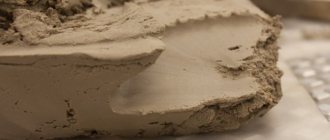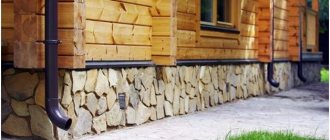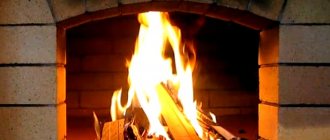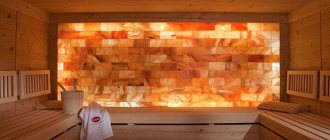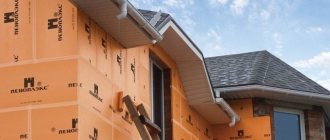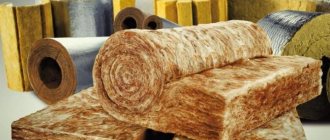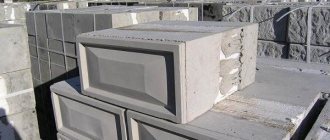Che Guevara
5518 0 0
Che Guevara November 22, 2016
Fire-resistant drywall from Lafarge.
In rooms with increased fire safety requirements, fire-resistant plasterboard can and should be used. In the article I will look at its main characteristics, show you how to choose the right non-flammable drywall, and also talk about its areas of application and installation features.
Fire-resistant drywall - what is it, pros, cons, scope of application
Fire-resistant plasterboard is a sheet of laminated material - gypsum board, covered in a cardboard shell. In addition to gypsum, the inner part includes clay, water and fiberglass, and the outer part contains a special impregnation of fire retardants. On the outside, the material has a characteristic red color.
Unlike standard gypsum plasterboard, fire-resistant plasterboard burns quite slowly or does not support combustion at all, depending on the conditions of fire spread. The period of direct flame retention ranges from 20 to 60 minutes and is determined by the following factors:
- The most compacted connection between cardboard and gypsum filler.
- Anti-flammable impregnation.
- Reinforcing structure made of fiberglass threads up to 30 mm long, preventing destruction under the influence of heat.
- Contains fireclay clay. Under the influence of high temperature, it sinteres and, strengthening the slab, prevents it from crumbling.
- Presence of crystal hydrates in the composition. When heated, they release water. As a result, the material becomes damp and extinguishes itself.
Structure of fire-resistant drywall Source pozharanet.com
All this makes it possible, if not to contain the spread of fire, then at least to slow down its spread until professional fire-fighting assistance arrives.
Advantages and disadvantages
The main advantages of fireproof gypsum plasterboard:
- Environmental friendliness, cleanliness, safety. Can be used in any room.
- High resistance to fire spread - up to 60 minutes.
- Increased moisture resistance - can be installed in rooms with a high degree of air humidity.
- Good noise and heat insulation due to the clay component included in the composition.
- Service life is at least 5 years.
- Convenient processing and installation.
- Versatility in finishing - suitable for plastering, painting, whitewashing, wallpapering and tiling.
- Preservation of the room microclimate.
- Reasonable price.
However, despite its good fire resistance, heat-resistant drywall creates a number of difficulties in installation and use - it is necessary to use special tools for cutting, high density and weight, the need for strengthening under loads, in addition, GKLO is not as water-resistant as GKLV or GKLVO.
Covering a room made of aerated concrete blocks with fire-resistant plasterboard Source pozharanet.com
Scope of application
Heat-resistant gypsum board has a wide range of applications:
- Finishing of main walls and load-bearing structures.
- Covering wooden surfaces to prevent fire.
- Manufacturing of fireproof boxes for laying communications.
- Construction of interior partitions.
- Creation of suspended ceilings.
- Insulation of chimneys.
- Finishing of stoves and fireplaces.
Note! GKLO can be equally effectively used to create interior partitions to prevent the spread of fire in the event of a fire. It can be used equally effectively for finishing fire-hazardous premises - boiler rooms, boiler rooms, walls in a bathhouse opposite the firebox - to prevent heating of building structures from hot elements.
See also: https://m-strana.ru/services/otdelochnye-materialy/
Installation features
The room was made with your own hands.
- During installation work with gypsum boards, only a metal profile for the frame should be used. No wood . When protecting wooden walls, foil mineral wool insulation is laid between the sheets and the walls. Expanded polystyrene or polystyrene foam should absolutely not be used.
Only a metal frame is used.
- External corner joints are reinforced with metal perforated corners. The remaining joints should be carefully taped with fiberglass tape (“serpyanka”) and treated with Fugen type putty.
For corners we use only a metal corner.
- Finishing sheets with putty and other types of finishing are no different from working with ordinary drywall. Due to the greater density and the presence of reinforcing fibers, cutting sheets and screwing in self-tapping screws is somewhat more difficult.
Otherwise, the finishing instructions do not differ from the generally accepted ones.
In general, installation is not much different from conventional construction work using gypsum boards. Here you should be more attentive to the joints; cut rectangular ends should be made with a chamfer of a third of the thickness. For the frame, joints and corners, use only non-combustible, fire-resistant materials.
Varieties
Modern manufacturers produce 4 main types of construction plasterboard:
- Standard. Gray in color, characterized as dry plaster for interior decoration with normal humidity.
- Moisture resistant. Green in color, it is resistant to dampness, fungi and mold.
Types of construction drywall Source stroy-podskazka.ru
- Fire resistant. Red in color, prevents fire.
- Moisture and fire resistant. Green in color, characterized by resistance to fire and humidity at the same time.
If ordinary gypsum board has a density of 800 kg/m³, then its fire-resistant analogue, due to the compacted fire-resistant gypsum included in the composition, is about 850 kg/m³. At the same time, increased strength and fire resistance is achieved by the presence of several impregnated layers.
Recommendation! One of the main disadvantages of drywall is its lack of strength with respect to external fasteners. Therefore, to mount heavy objects on the wall, it is necessary to use brackets with an increased contact area to maximize the distribution of the weight of the object being mounted over the surface.
Test procedure
It is carried out when serial commercial products are put into production, and then periodically - at least once a quarter; and also when changes are made to the production process, new materials and additives are introduced into the recipes of raw materials. According to GOST, the test procedure for fire resistance is similar, but according to GOST 32614 it is carried out under more stringent conditions:
- Take three sheets of plasterboard or 6 sheets of GSP from a batch of commercial products.
- Two gas burners are directed onto the cut sample to achieve a value of 800±30℃ - for gypsum plasterboard until destruction, measuring resistance to open flame in minutes, normally not less than 20 minutes; 1000±50℃ – for GSP for 15 minutes (normal) or until destruction.
- All samples are subjected to tests, and if at least one of them does not pass them, losing its integrity, collapsing into two or more parts; then the tests are considered unsatisfactory, the batch of GKLO, GKLVO or GSP-DF cannot be accepted as a fireproof/fire-resistant material.
Characteristics
A standard fire-resistant plasterboard sheet has the following set of technical characteristics:
- Dimensions – 250x120x1.25cm.
- Weight – 30kg.
- The category of combustion ability is G1 (corresponds to fireproof).
- Flammability class – B1 (meets fire resistance).
- Toxicity degree – T1 (non-toxic).
- Density – 850 kg/m³.
Finishing a fireplace using gypsum plasterboard Source gipsokarton-blog.ru
- The ability to conduct heat is 0.22 W/m².
- Smoke generation – D1 (does not produce smoke when exposed to fire).
Important! When choosing gypsum plasterboard for home finishing, among the main technical characteristics that you should pay attention to are fire-fighting properties (maximum temperature), as well as how fire-resistant and harmless the plasterboard is in terms of toxicity. This information is contained in the quality and fire safety certificate.
What is heat-resistant fireproof plasterboard used for?
At the beginning, it is worth saying that heat-resistant fire-resistant plasterboard is intended for use in premises where there are increased requirements for fire resistance and so-called “non-flammability”. Simply put, where constant work with fire sources takes place. Most often it is used in the finishing of industrial premises and boiler rooms. Also for lining fireplaces. It is often used in the manufacture of interior partitions, inside which electrical cables are laid. It is also used to decorate rooms where there are large crowds of people. For example, baths and saunas.
As you can see, its scope is very wide.
Criterias of choice
When choosing a fire-resistant plasterboard sheet, in addition to the technical characteristics and its purpose, you need to pay attention to the manufacturer’s brand. Since only an official factory can guarantee the declared properties of its products. Among the most popular brands are:
- Knauf.
- Belgyps.
- GYPROC.
- GIFAS.
- NORGIPS.
- Volma.
- Giproc.
- Rigips.
- Magma.
The prices and quality of products from the presented manufacturers are approximately the same. Therefore, when purchasing, first of all, the material must be checked according to the following criteria:
- External integrity - absence of cracks, breaks, potholes, etc. defects.
Only high-quality drywall will provide an airtight coating Source levelten.ee
- Coincidence of markings and inscriptions on the packaging and sign of the product - brand name, dimensions, model, GOST are indicated on the edge of the slab.
- Compliance with storage conditions - drywall must be kept at an ambient temperature of at least +10°C.
On a note! Fire-resistant drywall is not only harmless to the health of the residents of the house, but also useful - both as a non-flammable material and as a humidity regulator in the room. It easily absorbs excess moisture from the atmosphere, and when the air becomes excessively dry, on the contrary, it releases it, thereby stabilizing the home microclimate.
How does a material become fire retardant?
In addition to the increased density of the gypsum core, this type of material is characterized by additional reinforcing additives, as well as impregnation of the cardboard layer with special refractory compounds.
Interesting! Filament glass fiber acts as a reinforcing component that makes gypsum plasterboard heat-resistant. Its length can reach 30 millimeters, and the purpose of placing it in plaster is to maintain elasticity when exposed to high temperatures. In situations where regular plaster loses its strength, fire-resistant plaster has not yet reached its limit.
Briefly about the main thing
Fire-resistant plasterboard contains gypsum modified with clay and glass fibers at its core, and is covered on the outside with cardboard impregnated with fire retardants. Thanks to this structure, the material is able to hold back fire for 20 minutes to 1 hour without destruction. Its main advantages:
- Fire protection.
- Harmlessness.
- Moisture resistance.
- Sound and heat insulation.
- Durability.
- Versatility.
- Cheapness.
- Ability to maintain microclimate.
The disadvantages are expressed in the specifics of material processing and insufficient strength. GKLO is widely used for fireproofing, insulation, noise and thermal insulation. Among its varieties, fire-resistant and fire-moisture resistant stand out. When choosing, you need to pay attention to the technical characteristics, appearance, labeling and storage conditions before purchase. Installation of fire-resistant plasterboard boards is carried out using standard frame technology, but in compliance with recommendations regarding the specifics of the material.
Ratings 0
Fire resistance limit
The duration of the fire resistance limit determines the time during which the material will not be subject to destruction under the influence of open fire. The manufacturer indicates this limit with a number, which will indicate the time of resistance to open fire.
For heat-resistant drywall, this mark is designated as number 25. From the start of combustion of the material to the process of its destruction, 25 minutes can pass.
Even ordinary sheets of plasterboard can contain open fire for several minutes thanks to the gypsum layer, which is not subject to combustion.
In order for the material to be fire-resistant, double partitions are made in it, and cardboard is placed in the middle.
What kind of plasterboard fireplace to build?
For heating structures, the most rational choice is metal fireboxes. A wide selection of similar products, as well as their custom manufacturing, allow you to choose the best camera option. When choosing, they are guided by the estimated design of the device, the place and method of its installation, the type and size of the fireplace. You can purchase fireplace inserts from the options offered by manufacturers:
- Steel or cast iron;
- With internal lining with non-flammable heat-intensive materials (fireclay, refractory concrete, Aluker ceramics);
- Open and closed type;
- For wall mounting, recessed, corner placement;
- With panoramic glazing, with 1-3 sided glazing.
The safety of operating a fireplace with plasterboard cladding is at the forefront. Due to the nature of the sheet material, closed fireboxes with façade glazing are best suited for construction. Non-combustible materials are placed near the hearth: brick, stone, beautiful ceramic tiles, metal plate.
There are different methods of installing a fireplace, which determine the option of using plasterboard sheet:
- Portals made of plasterboard. This is an inexpensive way to decorate your fireplace beautifully. In this case, the wall near the firebox is lined with fireproof materials. A metal frame is attached to it. It can be simple rectangular, or made in a multi-level format, arched or column type. The sheets are cut to the required sizes. The blanks are used to sew up the frame, which forms the portal.
- Arrangement of a built-in fireplace in a plasterboard niche. A volumetric box is created from a metal profile. It provides space for installing a firebox. After completing the installation work, the frame is sewn up with gypsum plasterboard sheets. This method allows you to build a structure of the most unusual configurations - with asymmetrical placement, a wide-view firebox, in the form of a stove, etc. Such heating devices fit perfectly into modern interiors: art deco, cubism, hi-tech.
Convection grilles can be installed in such structures. They provide improved air exchange and better heating of the room.
When choosing a fireplace made of plasterboard, you can provide very useful details in the design: shelves, small niches for inserting decor, shaped holes, built-in lamps for original lighting, and more.
Methods for finishing plasterboard fireplaces
To give a plasterboard fireplace an aesthetic appearance, facing materials are used. Common finishing methods include:
- Coloring. Heat-resistant paints and varnishes are used. With their help, monolithic painting is carried out or a stencil, stylistic art drawing is applied.
- Ceramic tile. A simple way to make a device stand out from the overall interior. It is possible to use collectible tiles, ceramics with a glossy or matte texture, in any color tone or pattern.
- Stone cut. A successful way to decorate a fireplace that is visually no different from its luxury counterparts. The choice must be accompanied by qualified installation due to the possible large weight of the rocks used.
- Facing brick. Using facing bricks with a minimum thickness will allow you to imitate masonry. The finish from a cut of brick with a textured and colored front surface looks great.
- Plaster. A good option for finishing portal structures with a complex configuration, where the use of stone, tile, brick is difficult or impossible. Smooth or mineral plasters can be used to create a sparkling shine from a burning flame and make a plasterboard fireplace eye-catching and glaringly attractive.
Using GK panels for lining a fireplace insert
Drywall can be used for lining fireplaces and chimneys, taking into account the following notes and recommendations from manufacturers of chimney and fireplace systems:
- only suitable panels with the required thickness and fire-resistant properties (Nida Ogien type F or Nida Ogien Plus) should be used for the fireplace and chimney casing.
— drywall should not have direct contact with open fire and the walls of the firebox or chimney. It must be insulated on the inside, for example, with mineral wool, covered on one side with a layer of aluminum foil.
- Using commercially available casings, cover the fireplace or chimney with plasterboard so that the temperature of the plasterboard on the interior wall does not exceed 50 degrees C.
- only fire-resistant plasterboard, which does not emit harmful substances when heated strongly, can be used as a box for fireboxes operating on solid fuel.
